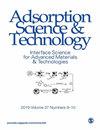金属-非金属改性二氧化钛单吸附和共吸附Cd(II)行为的电子尺度研究
IF 3.2
4区 工程技术
Q2 CHEMISTRY, APPLIED
引用次数: 3
摘要
利用金属(Fe)和非金属(P)对TiO2进行修饰,在其表面引入P-O、P=O、Fe-O和-OH等官能团,提高了TiO2对Cd(II)的吸附能力,吸附量可达121 mg/g。根据吸附性能的实验分析,化学吸附在吸附过程中占主导地位,吸附量在一定范围内随温度的升高而增大。竞争吸附实验结果表明,Pb(II)和Cu(II)对Cd(II)的吸附均有影响,P-Fe-TiO2对重金属离子的吸附顺序为Pb II > Cd II > Cu II。我们进一步研究了P-Fe-TiO2对Cd(II)的吸附机理和竞争吸附差异的原因,并利用DFT计算对实验结果进行了验证。在结合能和前沿分子轨道(FMOs)的分析中,我们证实了吸附过程中发生了电荷转移,因此发生了化学反应。P-Fe-TiO2与Pb(II)的结合能最大。竞争吸附实验结果也证实了吸附剂对铅的吸附效果最大。用Mulliken分析法确定吸附剂上的最佳结合位点。静电势、总势和差电荷分析的结果进一步证明了上述结论。本文章由计算机程序翻译,如有差异,请以英文原文为准。
Electron-Scale Insights into the Single and Coadsorption Cd(II) Behaviors of a Metal-Nonmetal-Modified Titanium Dioxide
Metal (Fe) and nonmetal (P) were used to modify TiO2, and then, several functional groups such as P-O, P=O, Fe-O, and -OH were introduced on its surface to enhance the adsorption capacity for Cd(II), which could reach 121 mg/g. According to the experimental analysis of adsorption performance, chemical adsorption dominates the adsorption process, and the adsorption capacity increases with increasing temperature within a certain range. The results of competitive adsorption experiments showed that both Pb(II) and Cu(II) affect the adsorption of Cd(II) and that the adsorption order of P-Fe-TiO2 for heavy metal ions is
Pb
II
>
Cd
II
>
Cu
II
. We further investigated the adsorption mechanism of P-Fe-TiO2 for Cd(II) and the reasons for the difference in competitive adsorption and used DFT calculations to confirm the experimental results. In the analysis of binding energy and frontier molecular orbitals (FMOs), we confirmed that charge transfer occurred during the adsorption process, so chemical reactions occurred. The binding energy of P-Fe-TiO2 and Pb(II) is the largest. The results of the competitive adsorption experiment also confirmed that the adsorbent has the greatest effect on Pb. Mulliken analysis was used to identify the best binding site on the adsorbent. The results of electrostatic potential, total potential, and differential charge analysis further prove the conclusions described above.
求助全文
通过发布文献求助,成功后即可免费获取论文全文。
去求助
来源期刊

Adsorption Science & Technology
工程技术-工程:化工
CiteScore
5.00
自引率
10.30%
发文量
181
审稿时长
4.5 months
期刊介绍:
Adsorption Science & Technology is a peer-reviewed, open access journal devoted to studies of adsorption and desorption phenomena, which publishes original research papers and critical review articles, with occasional special issues relating to particular topics and symposia.
 求助内容:
求助内容: 应助结果提醒方式:
应助结果提醒方式:


